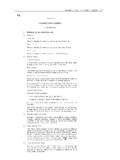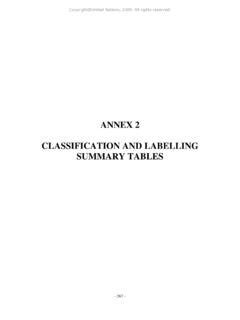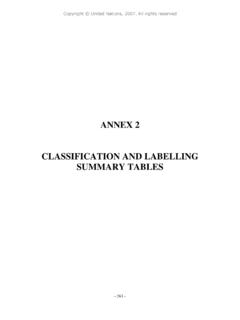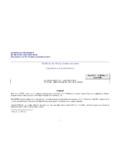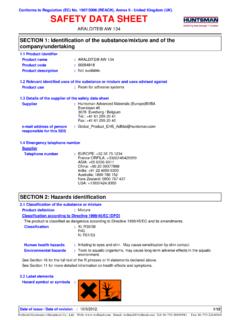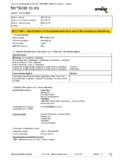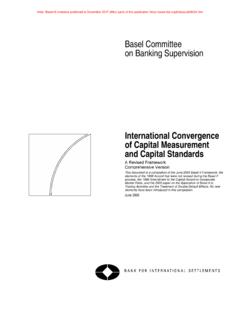Transcription of Version 2: July 2013 BULK CARGO HOLD WASH WATER …
1 Version 2: July 2013 THE INTERNATIONAL TANKER OWNERS POLLUTION FEDERATION LIMITED (ITOPF) 1, Oliver s Yard, 55 City Road, London EC1Y 1HQ, United Kingdom Tel: +44 (0)20 7566 6999, Fax: +44 (0)20 7566 6950, 24hr Pager: +44 (0)7626 398 4606 Email: Web: Registered in England No. 944863. Registered office as above BULK CARGO HOLD WASH WATER DISCHARGE AND CARGO DECLARATIONS UNDER MARPOL ANNEX V 1. INTRODUCTION As of 1st January 2013, amendments to MARPOL Annex V1,2 mean that shippers have new responsibilities regarding CARGO classification (crew responsibilities are outlined separately within Appendix 1), which also affect the ability of the crew to discharge residues and wash WATER into the marine environment.
2 From this date shippers will need to consider whether or not the CARGO and hence residues, including those contained in wash WATER , are harmful to the marine environment (HME), as illustrated in Figure 1. The following document sets out the requirements as well as the concept and process of classification of cargoes as HME. Fig 1. How the HME classification affects wash WATER discharge at sea. Outside Special Areas the discharge of HME CARGO residues contained in hold wash WATER is allowed under certain predefined conditions, until 31st December 2015. MARPOL ANNEX V The discharge of wash WATER and any non recoverable CARGO residues contained therein is primarily controlled through MARPOL Annex V, where it is classed as garbage and therefore subject to the controls specified within Regulations and of the recent amendments to MARPOL2.
3 In essence the discharge of CARGO residues contained in wash WATER is governed by the following criteria : No discharge of CARGO residues should occur less than 12 nautical miles from the nearest land, or the nearest ice shelf. No discharge of CARGO residues should occur within the six3 MARPOL defined Special Areas2 (the Mediterranean, the Gulfs area, the wider Caribbean including the Gulf of Mexico, the Baltic Sea, the North Sea and the Antarctic). The discharge of CARGO residues contained in wash WATER is only 1 Resolution (63). 2012 Guidelines for the implementation of MARPOL Annex V. Adopted 2nd March 2012. 2 Resolution (62). Amendments to the protocol of 1978 relating to the International Convention for the Prevention of Pollution from Ships, 1973.
4 Adopted 15th July 2011. 3 The other two Special Areas of the Black Sea and the Red Sea have not yet come into force. 26/1/2012. You currently submit a CARGO declaration under IMSBC Section 1stJanuary 2013 you also need to classify the CARGO as harmful to the marine environment (HME) or notAll CARGO residues and wash WATER are subject to MARPOL Annex V If CARGO is classified as HMEWash WATER may not be discharged overboard but should be received by an appropriate reception facility*Shippers of a solid bulk CARGO 2 permitted if both the destination and departure ports are within the Special Area and the ship will not transit outside the special area between these ports, and only provided that no adequate reception facilities (RF) exist.
5 In such instances discharge of non recoverable, non HME CARGO residues in hold wash WATER should take place as far out to sea as is practicable and, in any event, no less than 12 nautical miles from the nearest land or the nearest ice shelf. No discharge of any CARGO residues specified as HME. Hold wash WATER should be discharged to a suitable reception facility. *Note that due to a reported lack of adequate reception facilities at present, MEPC Circular 8104 allows the discharge of HME CARGO residues contained in hold wash WATER until 31st December 2015 outside Special Areas providing that; i) based on the information from the relevant port authorities, the master determines that there are no adequate RFs at the receiving terminal or at the next port of call, ii) the ship is en route and as far as practicable (but at least 12 nautical miles) from the nearest land, iii) before washing solid bulk cargoes are removed (and bagged for discharge ashore) as far as practicable (and the holds swept), iv) filters are used in the bilge wells to collect any remaining solid particles and v)
6 That the discharge is recorded in the garbage record book with the flag state notified utilising the revised consolidated format for reporting alleged inadequacies of port reception facilities stated in It is still a requirement for receiving terminals to provide adequate port reception facilities for this waste stream, this circular only provides flexibility for ship owners and operator in the case when receiving terminals have failed to meet their obligations under the Annex. Under the timeframe stipulated under MARPOL Annex V by ( from 1st January 2013 until 31st December 2014) the shipper must take all reasonable measures to provisionally classify cargoes as HME or not. From 1st January 2015 the shipper should provide a complete classification for the CARGO to be shipped.
7 The shipper must also declare whether the CARGO is HME or not to the port state authorities in the port of loading and unloading. 2. HOW TO CLASSIFY CARGOES AS HME (OR NOT) In order to classify a dry bulk CARGO under the MARPOL Annex V 2012 guidelines1 a CARGO is considered HME if it fails any of seven specified criteria , classed according to the UN Globally Harmonized System of classification and Labelling of Chemicals (UN GHS) as acute toxicity, chronic toxicity, carcinogenicity, mutagenicity, reproductive toxicity, repeated exposure of specific target organ toxicity [STOT] and the presence of plastics, rubber or synthetic polymers. Please see Appendix 3 for the specific data requirements for each criterion. When conducting laboratory testing the methods approved by the Organisation for Economic Co operation and Development (OECD) are recommended.
8 Once an assessment of all seven criteria is complete it may be useful to complete a summary table (as illustrated in Figure 2). An example overview of the process of classification has been illustrated in Figure 3. *Any one of the 7 criteria not met = CARGO is classed as harmful to the marine environment (HME). Fig. 2. An example summary box. 4 27/06/2013. Adequate port reception facilities for cargoes declared as harmful to the marine environment under MARPOL Annex V. 5 25/10/2012. Provisional classification of solid bulk cargoes under the revised MARPOL Annex V between 1 January 2013 and 31 December 2014.
9 3 Fig 3. Flow diagram illustrating an example of how to gather data required for HME classification . Is the CARGO a plastic, synthetic polymer or rubber? Conduct degradation / bioaccumulation tests (egOECD methods 301/302 and 107/117) CARGO is not rapidly degraded and has a high bioaccumulationCompare to known human and animal studies of CMR (categories 3,4,5) and STOT repeated exposure (category 6) CARGO is rapidly degraded and has a low bioaccumulationRecord as met criteria number 3/4/5/6 Record as not met criteria number 3/4/5/6 CARGO is classified as HMEYes No Yes No Then 4 There are three main stages in the classification of a CARGO using the 7 criteria : 1.
10 A literature search of available information, 2. Laboratory testing for toxicity, biodegradation and bioaccumulation, 3. The comparison of the biodegradation and bioaccumulation data with published carcinogenicity, mutagenicity and reproductive toxicity (collectively known as CMR) as well as STOT studies, if necessary. INTERNATIONAL MARITIME SOLID BULK CARGOES CODE (IMSBC) All vessels carrying solid bulk cargoes (except for grains6 transported in bulk, which are considered under the International Grains Code of 1991) are already required to comply with the IMSBC Code. The CARGO declaration form as required in Section of the Code may now contain a provisional declaration stating whether the CARGO is HME or not (an example of which is illustrated in Appendix 2).


